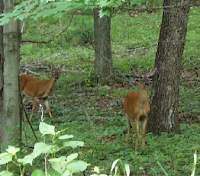I came across this post on a Nature Conservancy site. Thought I would share with my readers. The post was made on August 22nd on their Science page by Allen Pursell. On August 28th the story was picked up by Forbes writer William Pentland. I often speak about the impact of deer on forest regeneration and their influence on the predominance of invasive plants in Pennsylvania. Here are some numbers that I often share:
In timber stands that are only 40-70% stocked and in need of regeneration to replace trees that were harvested or died from natural causes nearly half lack the advanced regeneration necessary to regenerate.
When looking at only tree seedling species considered desirable for timber production: Almost 2/3's of the acres would likely fail to regenerate.
If we include all commercial species then: Half would likely fail to regenerate.
Lastly, if we include all woody species, this includes those that are not commercial or desirable, then we are still only at 54% meeting the regeneration criteria. Again, nearly half would fail to regenerate.
(2009 data collected by the US Forest Service Forest inventory and Analysis)
From what I have seen around the state this has not changed much over the past 4 years. I would suspect that very similar conditions still exist. Can all this be attributed to deer? Another study conducted in NW PA found that in 85% of the cases when the forest failed to regenerate simply excluding the deer made the difference. That leaves 15% of the failures attributed to other reasons. Give the below articles a read and let me know what you think? Is this issue bigger than climate change? Are these reasons to begin engaging our youth?
Here is a link to a Penn State Extension publication and curriculum you may find interesting and helpful when engaging youth.
From the Woods: White-tailed Deer
White-tailed Deer Lesson Plans
Too Many Deer: A Bigger Threat to Eastern Forests than Climate Change?
(The Nature Conservancy, August 22, 2013)
In August, 2012 The Bloomberg View published a staff editorial entitled Deer Infestation Calls for Radical Free-Market Solution. The Wall Street Journal then ran a story in November 2012 entitled America Gone Wild, noting the impact of overabundant deer. If business news organizations can talk freely about deer, The Nature Conservancy (TNC) needs to speak openly as well. Aldo Leopold long ago warned us of the problems of a growing deer herd. Have we waited too long to heed his advice, or is there still time to reverse the damage done?
No native vertebrate species in the eastern United States has a more direct effect on habitat integrity than the white-tailed deer. There are no hard numbers, but in many states deer populations continue to rise well beyond historical norms. In many areas of the country deer have changed the composition and structure of forests by preferentially feeding on select plant species.
To read the full story click here.
Move Over Global Warming! White-tailed Deer Pose Biggest Threat to East Coast Forests
(Forbes, August 28, 2013)
The rapidly rising population of white-tailed deer pose a more significant threat to forest habitats across the eastern United States than global warming according to a new study by The Nature Conservancy.
To read the full story click here.

No comments:
Post a Comment